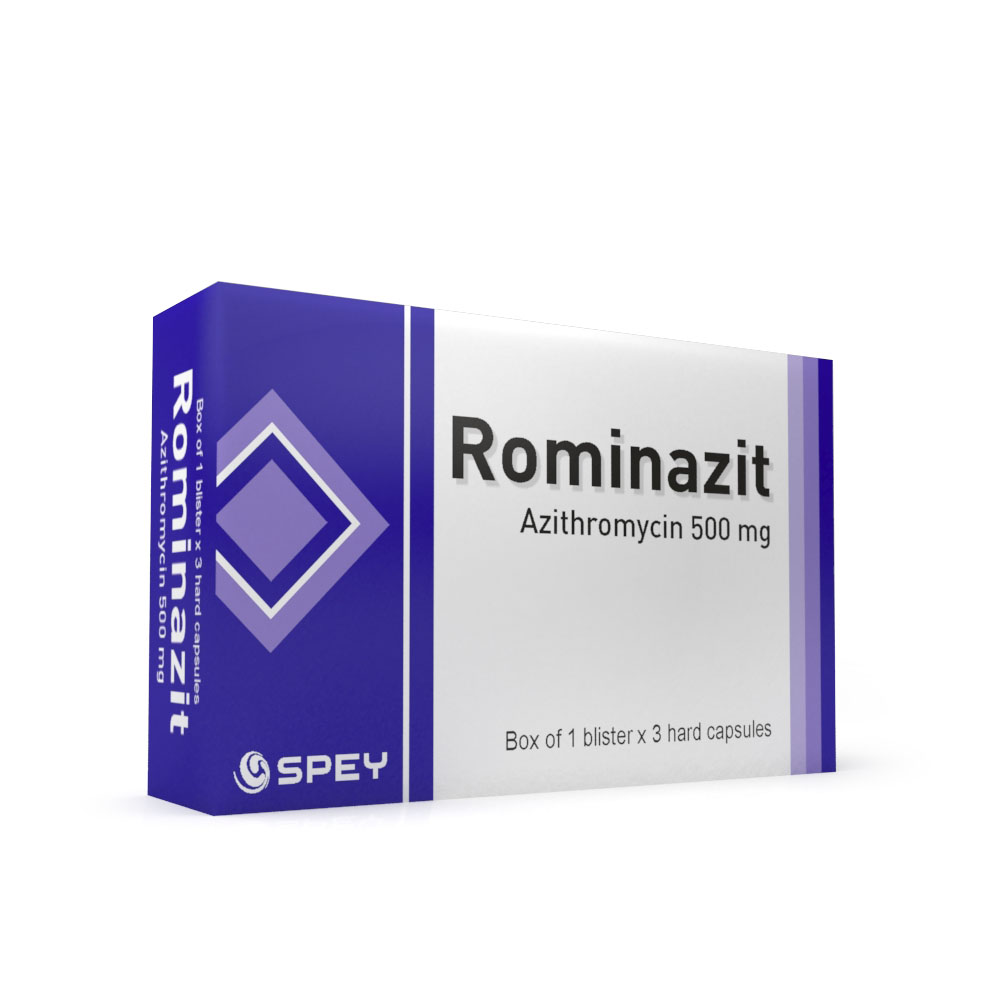
Azithromycin in Rominazit is a macrolide antibiotic belonging to the azalide group. The mechanism of action of azithromycin is based mainly upon the suppression of bacterial protein synthesis by means of binding to the ribosomal 50s sub-unit and inhibition of peptide translocation.
Azithromycin – 500 mg
Rominazit is indicated in adults and children weighing more than 45 kg for the treatment of infections known or suspected to have been caused by one or more azithromycin- susceptible microorganisms:
• Upper res p i ratory tract i nfecti ons – pharyng itis/ton si I litis, sinusitis and otitis media
• Lower respiratory tract infections – bacterial bronchitis and community acquired pneumonia
• Skin and subcutaneous tissues – moderate acne vulgaris, erythema chronicum migrans (first stage of Lyme disease), erysipelas, impetigo and secondary pyoderma
• Sexually transmitted diseases – uncomplicated urethritis and cervicitis caused by Chlamydia trachomatis.
The use of the product should be in line with national and local guidelines and recommendations for conducting antibacterial therapy.
Adults, including the elderly and children weighing more than 45 kg
Children weighing less than 45 ka: Rominazit 500 mg capsules are not recommended in children weighing less than 45 kg, due to the lack of accurate dosing.
Renal impairment: No dose adjustment is required in patients with mild to moderate renal impairment (creatinine clearance >40 ml/min).
Caution should be exercised in patients with severe renal impairment (creatinine clearance <40 ml/min) (see section 4.4).
Hepatic impairment: Since azithromycin is metabolised in the liver and excreted in the bile, the product in contraindicated in patients suffering from severe liver diseases. No studies have been conducted in relation to the use of azithromycin in this patient group.
Method of administration: Rominazit capsules should be swallowed whole, as a single daily dose. Like the other antibiotics, the product should be taken at least one hour before or two hours after meal.
Mode of Administration: Oral
Azithromycin – 500 mg
Rominazit is indicated in adults and children weighing more than 45 kg for the treatment of infections known or suspected to have been caused by one or more azithromycin- susceptible microorganisms:
• Upper res p i ratory tract i nfecti ons – pharyng itis/ton si I litis, sinusitis and otitis media
• Lower respiratory tract infections – bacterial bronchitis and community acquired pneumonia
• Skin and subcutaneous tissues – moderate acne vulgaris, erythema chronicum migrans (first stage of Lyme disease), erysipelas, impetigo and secondary pyoderma
• Sexually transmitted diseases – uncomplicated urethritis and cervicitis caused by Chlamydia trachomatis.
The use of the product should be in line with national and local guidelines and recommendations for conducting antibacterial therapy.
Adults, including the elderly and children weighing more than 45 kg
Children weighing less than 45 ka: Rominazit 500 mg capsules are not recommended in children weighing less than 45 kg, due to the lack of accurate dosing.
Renal impairment: No dose adjustment is required in patients with mild to moderate renal impairment (creatinine clearance >40 ml/min).
Caution should be exercised in patients with severe renal impairment (creatinine clearance <40 ml/min) (see section 4.4).
Hepatic impairment: Since azithromycin is metabolised in the liver and excreted in the bile, the product in contraindicated in patients suffering from severe liver diseases. No studies have been conducted in relation to the use of azithromycin in this patient group.
Method of administration: Rominazit capsules should be swallowed whole, as a single daily dose. Like the other antibiotics, the product should be taken at least one hour before or two hours after meal.
Mode of Administration: Oral